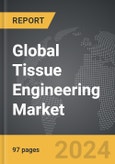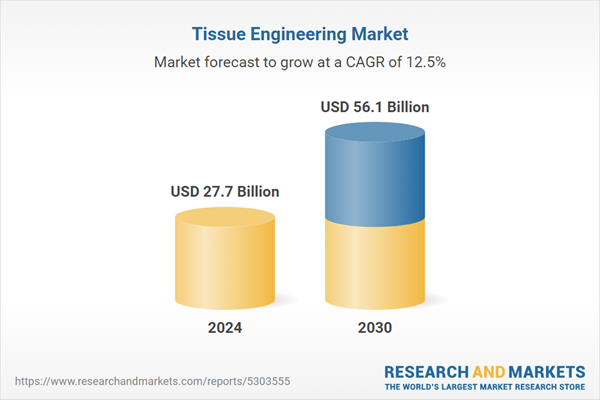The global market for Tissue Engineering was valued at US$27.7 Billion in 2024 and is projected to reach US$56.1 Billion by 2030, growing at a CAGR of 12.5% from 2024 to 2030. This comprehensive report provides an in-depth analysis of market trends, drivers, and forecasts, helping you make informed business decisions. The report includes the most recent global tariff developments and how they impact the Tissue Engineering market.
Segments: Application (Orthopedics, Musculoskeletal & Spine, Cardiology & Vascular, Cord Blood & Cell Banking, Cancer, Gastrointestinal & Gynecology, Other Applications).
Geographic Regions/Countries: World; United States; Canada; Japan; China; Europe (France; Germany; Italy; United Kingdom; and Rest of Europe); Asia-Pacific; Rest of World.
The analysts continuously track trade developments worldwide, drawing insights from leading global economists and over 200 industry and policy institutions, including think tanks, trade organizations, and national economic advisory bodies. This intelligence is integrated into forecasting models to provide timely, data-driven analysis of emerging risks and opportunities.
Global Tissue Engineering Market - Key Trends and Drivers Summarized
How Is Tissue Engineering Redefining Regenerative Medicine?
Tissue engineering is a cutting-edge field that combines the principles of biology, materials science, and engineering to create artificial tissues or organs. These tissues are developed using biocompatible scaffolds, living cells, and biochemical factors to regenerate damaged tissues and improve organ function. Tissue engineering has found extensive applications in the treatment of severe burns, cardiovascular diseases, organ failures, and musculoskeletal injuries, transforming healthcare by providing alternatives to donor transplants. This innovative approach also reduces the risks of organ rejection and eliminates long waiting times for transplants, marking a significant leap in regenerative medicine.What Are the Key Segments in the Tissue Engineering Market?
The key materials used in tissue engineering include synthetic materials, biologically derived materials, and composite materials. Among these, synthetic materials hold a significant share due to their controlled properties, availability, and lower costs. Applications of tissue engineering cover orthopedics, cardiology, dermatology, and neurology, with orthopedics representing the largest segment. The high demand in orthopedics is driven by the need for artificial ligaments, tendons, and cartilage, improving mobility and quality of life for patients with joint and bone disorders. End-users of tissue engineering include hospitals, research institutions, and specialty clinics. Hospitals lead the market, primarily using engineered tissues in reconstructive surgeries, burn treatments, and organ replacements. Research institutions are actively involved in developing new tissues for clinical applications, advancing the field with innovations like bioengineered skin, cartilage, and heart valves. Specialty clinics employ tissue-engineered solutions for cosmetic and reconstructive procedures, such as facial reconstruction and skin grafting, enhancing aesthetic outcomes and functional recovery.How Is Tissue Engineering Applied in Modern Healthcare?
In hospitals, tissue engineering is used in reconstructive surgeries to regenerate skin, bones, and muscles, especially for burn victims and accident survivors. In orthopedics, tissue-engineered cartilage and tendons offer better outcomes for joint repair and mobility restoration. In cardiology, researchers are developing tissue-engineered heart valves and blood vessels, aiming to treat cardiovascular diseases without the need for donor organs. In dermatology, tissue-engineered skin is used for chronic wound management and cosmetic surgeries, offering improved recovery times and reduced scarring. The use of advanced scaffolds and bioreactors has accelerated the development and application of tissue-engineered products across different medical specialties.What Factors Are Driving the Growth in the Tissue Engineering Market?
The growth in the Tissue Engineering market is driven by several factors, including increasing demand for organ transplants, advancements in biomaterials, and growing research funding in regenerative medicine. Innovations like 3D bioprinting, bioactive scaffolds, and stem cell integration have supported broader applications, expanding the scope of tissue engineering in clinical settings. The focus on reducing organ transplant wait times, minimizing rejection risks, and improving patient outcomes has further fueled demand, as tissue engineering offers promising solutions for chronic diseases and injuries. Additionally, rising healthcare expenditure, supportive regulatory frameworks, and increasing awareness of advanced treatment options have contributed to market growth, encouraging adoption across healthcare systems globally.Report Scope
The report analyzes the Tissue Engineering market, presented in terms of units. The analysis covers the key segments and geographic regions outlined below.Segments: Application (Orthopedics, Musculoskeletal & Spine, Cardiology & Vascular, Cord Blood & Cell Banking, Cancer, Gastrointestinal & Gynecology, Other Applications).
Geographic Regions/Countries: World; United States; Canada; Japan; China; Europe (France; Germany; Italy; United Kingdom; and Rest of Europe); Asia-Pacific; Rest of World.
Key Insights:
- Market Growth: Understand the significant growth trajectory of the Orthopedics, Musculoskeletal & Spine segment, which is expected to reach US$12.7 Billion by 2030 with a CAGR of a 10.2%. The Cardiology & Vascular segment is also set to grow at 15.0% CAGR over the analysis period.
- Regional Analysis: Gain insights into the U.S. market, valued at $7.6 Billion in 2024, and China, forecasted to grow at an impressive 12.0% CAGR to reach $8.7 Billion by 2030. Discover growth trends in other key regions, including Japan, Canada, Germany, and the Asia-Pacific.
Why You Should Buy This Report:
- Detailed Market Analysis: Access a thorough analysis of the Global Tissue Engineering Market, covering all major geographic regions and market segments.
- Competitive Insights: Get an overview of the competitive landscape, including the market presence of major players across different geographies.
- Future Trends and Drivers: Understand the key trends and drivers shaping the future of the Global Tissue Engineering Market.
- Actionable Insights: Benefit from actionable insights that can help you identify new revenue opportunities and make strategic business decisions.
Key Questions Answered:
- How is the Global Tissue Engineering Market expected to evolve by 2030?
- What are the main drivers and restraints affecting the market?
- Which market segments will grow the most over the forecast period?
- How will market shares for different regions and segments change by 2030?
- Who are the leading players in the market, and what are their prospects?
Report Features:
- Comprehensive Market Data: Independent analysis of annual sales and market forecasts in US$ Million from 2024 to 2030.
- In-Depth Regional Analysis: Detailed insights into key markets, including the U.S., China, Japan, Canada, Europe, Asia-Pacific, Latin America, Middle East, and Africa.
- Company Profiles: Coverage of players such as Acelity L.P. Inc., Advanced Cell Technology, Allergan Plc, Arteriocyte, Athersys and more.
- Complimentary Updates: Receive free report updates for one year to keep you informed of the latest market developments.
Some of the 49 companies featured in this Tissue Engineering market report include:
- Acelity L.P. Inc.
- Advanced Cell Technology
- Allergan Plc
- Arteriocyte
- Athersys
- Baxter International Inc
- BioMimetic Therapeutics
- Cook Biotech Inc.
- CryoLife
- DePuy Synthes (Johnson & Johnson Services, Inc.)
- Integra Life Sciences Corporation
- LifeCell Kinetic Concepts
- Medtronic
- Organogenesis Inc.
- RTI surgical
- Sanofi
- StemCells, Inc.
- Stryker Corporation
- Zimmer Biomet
Tariff Impact Analysis: Key Insights for 2025
Global tariff negotiations across 180+ countries are reshaping supply chains, costs, and competitiveness. This report reflects the latest developments as of April 2025 and incorporates forward-looking insights into the market outlook.The analysts continuously track trade developments worldwide, drawing insights from leading global economists and over 200 industry and policy institutions, including think tanks, trade organizations, and national economic advisory bodies. This intelligence is integrated into forecasting models to provide timely, data-driven analysis of emerging risks and opportunities.
What’s Included in This Edition:
- Tariff-adjusted market forecasts by region and segment
- Analysis of cost and supply chain implications by sourcing and trade exposure
- Strategic insights into geographic shifts
Buyers receive a free July 2025 update with:
- Finalized tariff impacts and new trade agreement effects
- Updated projections reflecting global sourcing and cost shifts
- Expanded country-specific coverage across the industry
Table of Contents
I. METHODOLOGYII. EXECUTIVE SUMMARY2. FOCUS ON SELECT PLAYERSIII. MARKET ANALYSISIV. COMPETITION
1. MARKET OVERVIEW
3. MARKET TRENDS & DRIVERS
4. GLOBAL MARKET PERSPECTIVE
UNITED STATES
CANADA
JAPAN
CHINA
EUROPE
FRANCE
GERMANY
ITALY
UNITED KINGDOM
REST OF EUROPE
ASIA-PACIFIC
REST OF WORLD
Companies Mentioned (Partial List)
A selection of companies mentioned in this report includes, but is not limited to:
- Acelity L.P. Inc.
- Advanced Cell Technology
- Allergan Plc
- Arteriocyte
- Athersys
- Baxter International Inc
- BioMimetic Therapeutics
- Cook Biotech Inc.
- CryoLife
- DePuy Synthes (Johnson & Johnson Services, Inc.)
- Integra Life Sciences Corporation
- LifeCell Kinetic Concepts
- Medtronic
- Organogenesis Inc.
- RTI surgical
- Sanofi
- StemCells, Inc.
- Stryker Corporation
- Zimmer Biomet
Table Information
| Report Attribute | Details |
|---|---|
| No. of Pages | 97 |
| Published | April 2025 |
| Forecast Period | 2024 - 2030 |
| Estimated Market Value ( USD | $ 27.7 Billion |
| Forecasted Market Value ( USD | $ 56.1 Billion |
| Compound Annual Growth Rate | 12.5% |
| Regions Covered | Global |









